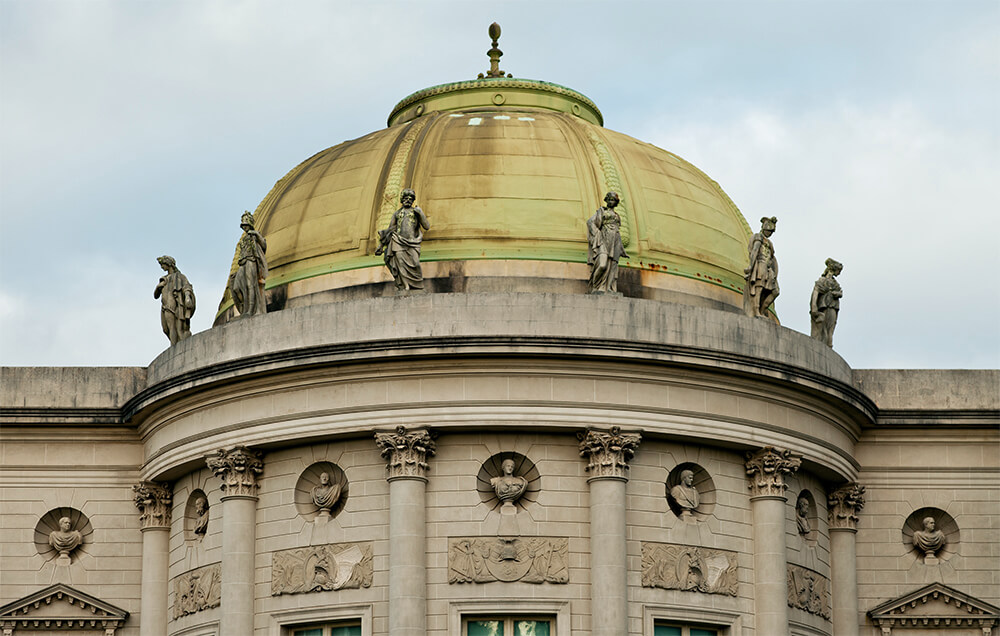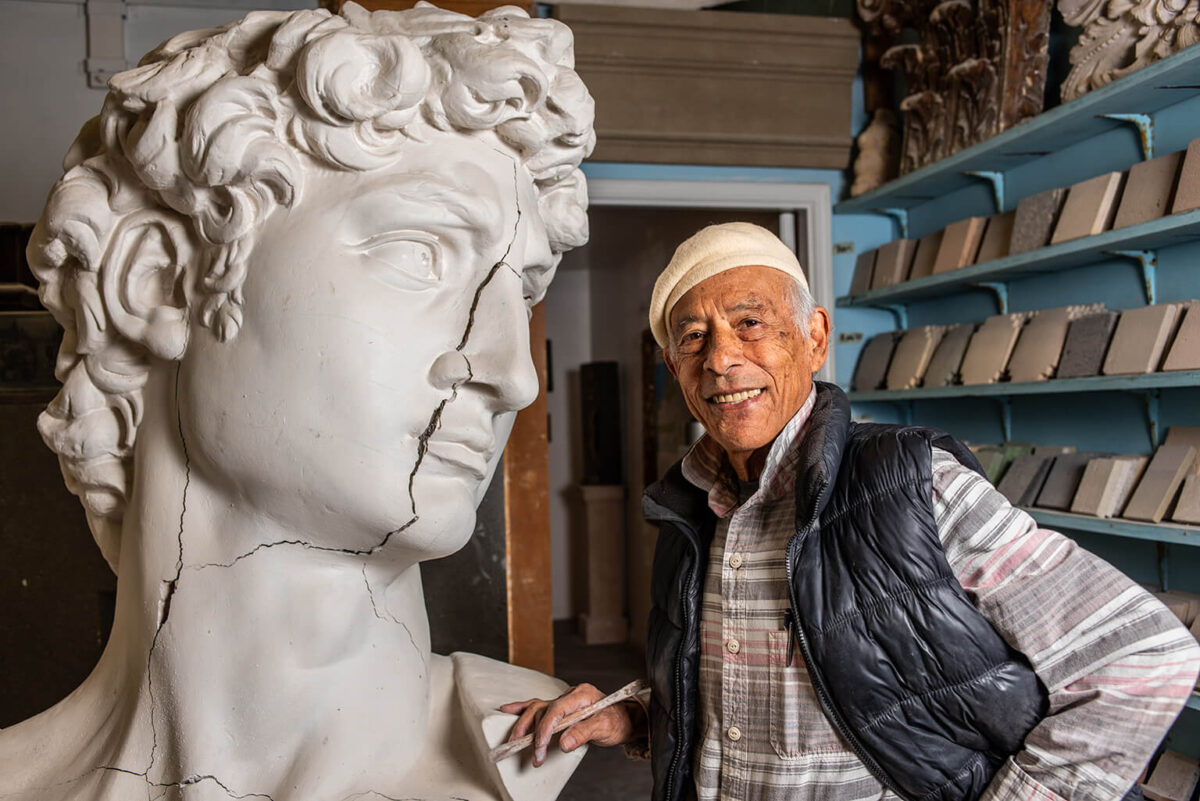Words by Johanna Harlow
In a warehouse near Candlestick Point, Greek figures intermingle with medieval dragons, busts and big cats. While half-finished works await, chunks of stone and a powdering of rock dust on the floor show the layers shed by sculptor Manuel Palos’ stony creations—the archeological representation of a lifetime of work.
This afternoon, Manuel—his shirt the color of brick, his beret a shade of sandstone—considers a partially-molded woman on his worktable. “It’s not just jumping in. You’ve got to talk to them first,” Manuel explains as he holds the figure’s gaze. “My goal is to make a connection with each piece that I work on. This allows me to feel their energy and it guides me on how they want to be created.” Gently cupping her clay hand, Manuel finesses her fingers with a tiny wooden paddle. “Some days, they may not want to be touched, so I step away and work on something else. They let me know when they are ready to work together again.”

With over half a century of work under his chisel, Manuel’s handiwork can be found throughout the Peninsula, San Francisco and Mexico. He’s done it all. Bronze, marble, stone, clay. Classic, modern, art deco. Historical preservations, ornamental pieces, figure work. Commissions for doctors, lawyers, educators and politicians. And the 85-year-old shows no signs of slowing down. “Any item, any style, whatever they want—I’ll do it,” he promises.
Though Manuel welcomes all projects, he prefers figurative to decorative work. “I respect both,” he insists, but “figures are more meaningful than just a leaf. They’re more challenging.” When someone commissions the artist for a portrait, the process is personal. “First of all, I like to talk to the person and look in their eyes,” he shares. “Their smile… The way they laugh and talk… That’s the first thing I capture.” He then takes photos of his subject in different poses, both playful and serious. “That’s how you start to get the figure: the personality,” he observes.
It’s a fascination that has enthralled Manuel since childhood. “When I was a kid, my brother and I used to make little figurines in clay,” he recalls of his youth growing up in the Mexican state of Zacatecas. “We used to sell them for pennies.” This afforded the boys luxuries like candy and trips to the cinema. “We didn’t have to ask Papa for money to go to the movies!” he chuckles.

Manuel’s smile reveals a scar. Carved from lip to chin, he received it from a harrowing car accident that killed a dear friend. “I was lucky,” Manuel shakes his head. “I had a lot of work to do yet.”
And he set out to do it. In his late twenties, Manuel moved from Southern California to San Francisco to work as a moldmaker on the reconstruction of the Palace of Fine Arts. Back then, sculptors were in scarce supply in the City, the artist reflects. “We were working with people from different countries because they couldn’t find anyone here.” Many connected with the project through an ad in an international publication, flying from far-off places like France, Spain and Italy to offer their services.
Not long after joining the team, Manuel found himself elevated to assistant to the sculptor, aiding with scrollwork and colossal figures. “I learned how to work in that scale,” he notes. Surrounded by talented artists, Manuel thrived. “I learned from all of them,” he says. When they gave him advice, he listened. “They told me, ‘Manuel, you’re good at this. You should go to Italy. We are old already and we can’t teach you more.’”

To date, he’s taken more than 30 trips to perfect his craft—at workshops in Pietrasanta and Carrara and by soaking in the presence of the Masters. “That was a dream,” he reflects. “I saw the best there.” He cites Florence as his favorite Italian city, but adds that he discovered inspiration all over. “Everywhere you go, you see art!”
After recreating a fleet of 13-foot eagles to perch atop the Pacific Telephone Building (the tallest building in SF at the time), Manuel was hired to remake six larger-than-life mythological figures for the domed roof of the Legion of Honor museum—no easy task. “I was scared at the beginning, you know?” concedes Manuel. “Sometimes at night, I’d ask, ‘What am I doing? What am I doing?’ But then the next day, ‘Let’s go!’”

Over the years, Manuel’s Peninsula projects have ranged from planters for Stanford Shopping Center to hand-carved detailing and stonework for private residences—most impressively Hillsborough’s Chiltern Estate. For this luxurious castle-esque mansion, Manuel crafted interior arches and columns as well as eight chimney stacks designed to look like pillars. In Woodside, the Family Farm club commissioned Manuel to create a striking bronze stork.
Other memorable projects include additions to the famed Neiman Marcus rotunda in San Francisco and the Veterans Memorial Building in Berkeley. Manuel’s work is so prolific, in fact, that the mayor recognized him with his own San Francisco day on August 11 (Manuel’s birthday).

Another claim to fame for Manuel: the massive stone dragon fireplace he crafted for Nicholas Cage back in the ‘90s. When the shaggy-haired actor first showed up to wander the warehouse, Manuel had no idea who the man was. “I thought he was a hippie,” Manuel laughs. So when Cage requested a dragon to put above his fireplace, Manuel assumed he was kidding. “I’m gonna play his joke,” the artist remembers thinking. “I said, ‘No, I have a better idea! Why don’t I give you a big, big dragon—then you put the fireplace in the mouth!” Cage, a fan of all things Goth, enthusiastically agreed—and when Manuel received the check, he finally realized the guy was serious. The result was a fearsome 13-foot-tall creature, all claws and spikes and teeth. Manuel is currently babysitting the 4.5-ton beast while its owner moves into his new place.
Beyond his original work, Manuel also has a penchant for preservation. Frequently, he restores (or recreates) crumbling historical elements for public buildings, homes, parks and other sites. Also a collector, Manuel’s antiques range from a Victorian-era limestone griffin to a 16th-century marble nativity scene salvaged from a church in Tuscany. Manuel points out cracks in the nativity scene that he will soon seal with epoxy. “They told me that after World War II, many art pieces were broken or damaged,” he notes. “But look at the details!
His ongoing pet project involves a series of colossal Mayan molds bequeathed to him by the late Joan Patten. Back in the ‘60s, Manuel learned of this intrepid sculptress and her efforts to track down Mayan ruins in the jungles of Guatemala, preserving them with massive latex molds. At the time, she was the only person authorized by the Guatemalan government to make reproductions of these ancient works.

“She was looking for someone who had expertise in sculpting and moldmaking to assist her with the restoration of the molds,” Manuel explains. “Joan knew that I had the same vision as her in preserving these beautiful treasures so that future generations can benefit and learn from them.” These giant inscribed slabs, some over 20 feet tall, are weighty with history. “It’s a whole world up there,” Manuel describes, tilting his head at an ancient prince with a headdress of resplendent quetzal feathers.
“We want to give them a proper home,” adds Manuel’s daughter, Alejandra Palos, who manages her father’s studio and is a sculptor in her own right. Both father and daughter hope to see replicas displayed at universities and museums. “I mean, their home is here. But we want to give others the opportunity to really see them and to experience them,” Alejandra shares. “Scholars can learn from them and classes could be held about them.”
Looking to the future as well as the past, Manuel instructs the next generation of sculptors at his San Francisco and Puerto Vallarta studios. Both beginners and more advanced students are welcome. “Visualize your final creation and take the necessary steps to get it done,” he advises sculptors of all levels. “It can be frustrating at times, when it may not be going how you would like it to. That’s why it is so important to build a relationship with your creations.”
But don’t misunderstand: Manuel isn’t passing off the torch. “I’m still alive! I’ve got a long way to go,” the octogenarian asserts with a youthful grin and a determined glint in his eyes.


